Overview of the ASUS MATRIX HD 7970 Platinum
This packaging is similar to what we have seen on the ROG motherboards and also previously on the MATRIX GTX 580 Platinum. The box is red in color and for the most part the front panel has very little spec info except the product name and a few small icons at the bottom edge. Also, a small image of the included Diablo III mousepad made by Steelseries is shown on the front as well. Flipping open the front flap there is a windowed opening showing the card off just a little.
The top of the flap shows a bunch of feature info, most of which can be found on the previous page of this review. The rear of the box has more info, this time mostly specs about the card and what it supports.
Here is what we see when we open the box. The topmost small box carries these accessories:
- Installation Disc
- Instruction Manual
- MOSFET Heatsink for LN2 benchmarking usage
- VGA Hotwire Cables
- Dual 6 Pin PCIe to 8 Pin PCIe Adapter
- DVI>VGA Adapter
- Crossfire Bridge
- ROG Case Badge
- Diablo III Mousepad
The accessory package is vast and covers a whole gamut of possibilities for the MATRIX card. The LN2 MOSFET heatsink is very cool as it gives a good impression of what this card was built for. It enables MOSFET cooling when the GPU is cooled by an LN2 pot.
Click Images to Enlarge
Here we see the card. It is absolutely huge, and like most other DirectCU II top-end enthusiast-class models, it is triple slot. The card looks like an absolute monster and we’re betting would look awesome in any ROG themed gaming build.
Click Images to Enlarge
The rear of the PCB is covered mostly by a backplate with exception to key areas and components for modification or other needs. Also note how tall the PCB is above the IO bracket, which speaks to the sheer level of engineering and components that ASUS needed to fit in this card.
Click Images to Enlarge
The I/O of the MATRIX card is awesome for enthusiast users as it has dual DVI ports and Quad DisplayPorts for Eyefinity 6 support. The card has 4K support as well. This allows for an amazing array of displays for a veritable wall of monitors.
Popping the Top off the TOP
Click Images to Enlarge
The heatsink comes off rather easy as it is a 4 screw mounting, and then it just pops off. The PCB is gigantic: it’s bigger than a smartphone, and about as wide as a game case from the PCI-E slot to the top. This thing is absolutely huge. you can also get a good look at the VRM layout and some of the overclocking features/buttons and controls even though most of the power components are shrouded by the full frame cooling plate.
Click Images to Enlarge
Here you can see the sheer size of the PCB over a more standard size card. As you can see it is well over an inch taller. This space is there for a reason as it houses a very advanced PWM design along with many special ROG controls designed for fine tuning the card. The DirectCU II Heatsink has a solid copper base which sandwiches the heatpipes to allow maximum thermal transfer for the lwoest possible temperatures and betetr overclocking headroom.
Click Images to Enlarge
After removing the heat spreader plate I find it a little curious that 33% or 4 of the 12 VRAM chips were left uncovered and therefore were not cooled by the heatspreader plate. This is likely not an issue but I do wonder if it could affect the overall clockability of the VRAM as a whole. We will find this out soon as we test how far this card can be pushed on its DirectCU II MATRIX cooler. The Heatspreader frame itself adds some definite rigidity to the PCB as it attaches and sandwiches the PCB between the frame and backplate.
Click Images to Enlarge
Here we get a glimpse of the 20 Phase GPU VRM which honestly is quite astonishing as the reference card already has a pretty beefy 12 Phase VRM. The MATRIX has to have more, because a better VRM means more headroom when pushing the limit on the card especially for the extreme enthusiasts.
The Digital controller for the VRM is a DIGI+ design and allows for very finite levels of control and voltage accuracy. The DIGI+ controller has been used on many cards and boards I have tested previously and I can say with absolute certainty that the performance is excellent and voltage stability and accuracy when overclocking is excellent.
Here are the TweakIT buttons which allow quick easy voltage control in real time to allow necessary adjustment during bench sessions. Also there is a Safe Mode switch which can help reset the BIOS to fix most issues caused by a crashed overclock on the card which can save a lot of headache especially if the rig is frozen on LN2.
The 100% fan speed switch is pretty what what it looks like, as it sets full fan speed and also makes some key optimizations to the TweakIT settings and boost clock as well.
Click Images to Enlarge
This card has a dual BIOS, much like other HD 7970 cards we’ve seen. The BIOS selection is controlled by the toggle as you see in the first image above. This toggle is located directly in front of the CrossFire Bridge connectors.
Looking at the far edge of the card you can see the previously mentioned modding zone where all of the solder mods can be made to enable features such as LN2 mode, or even disable the overvoltage protection of the GPU.
The Dual 8 Pin power connectors are employed to make sure the GPU has plenty of juice on tap. Here we also see the dual LED’s per plug to light up red or green depending upon if the card sees proper power delivery being made into that plug port.
Lastly you can see two of the three plugs that the VGA Hotwire connectors can be plugged into which will enable hardware level voltage adjustment to the card without the need to solder wires on the card like was required previously.
Click Images to Enlarge
Here are the dual 8 pin power plugs from the front of the card. This is a sign that a beefy power supply is recommended to ensure there is plenty of amperage when pushing the limits.
The memory used on this card is Hynix model : H5GQ2H24AFR-R0C which is rated for 6.0Gb/s operation. The memory comes clocked out of the box at 1650MHz (6600MHz Effective) but i am betting with this card and power design there is some headroom left in these things.
Here we see the GCN 28nm Tahiti GPU. This is a very powerful moster of a GPU and knowing it is a hand sorted unit for MATRIX platinum models means it will be even better. The out of the box clock for the GPU is 1100MHz but im betting just like the memory there is some headroom left in this one as well.
 Bjorn3D.com Bjorn3d.com – Satisfying Your Daily Tech Cravings Since 1996
Bjorn3D.com Bjorn3d.com – Satisfying Your Daily Tech Cravings Since 1996

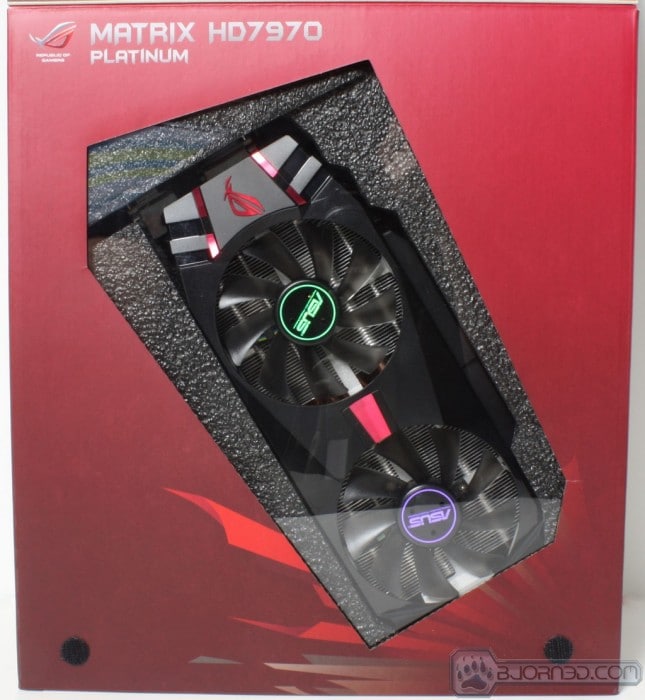

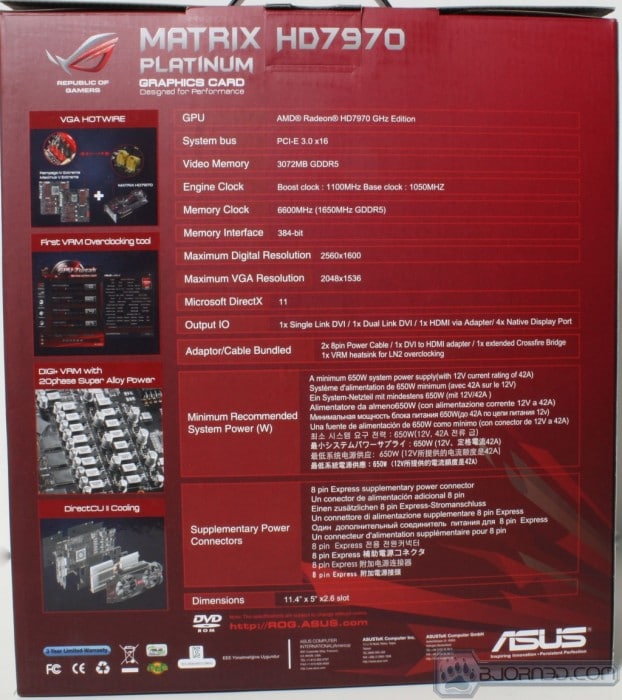
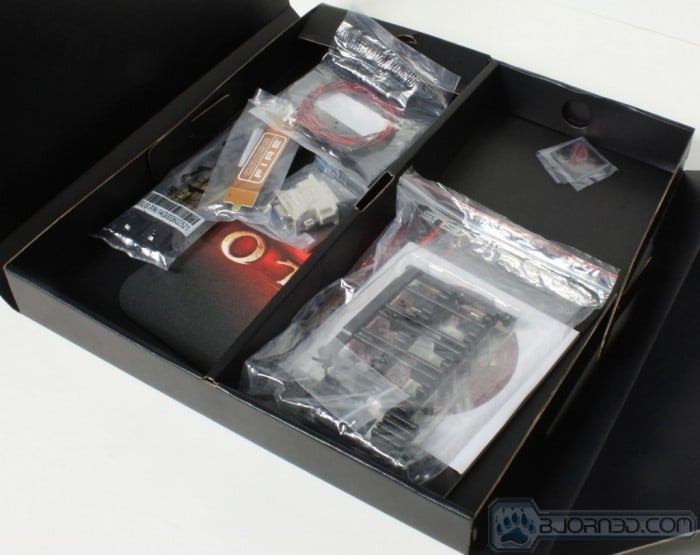

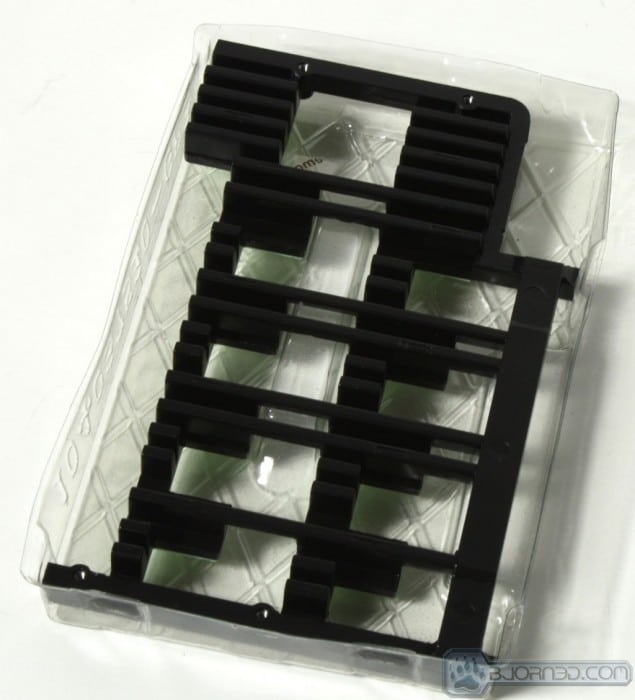

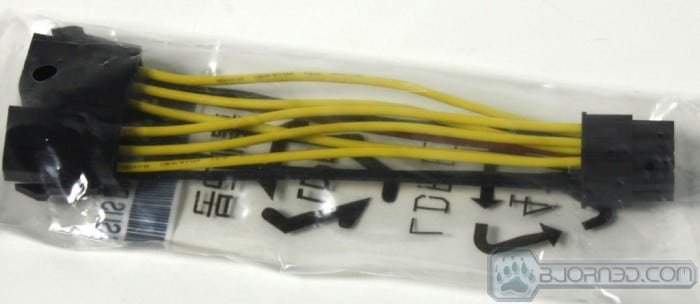

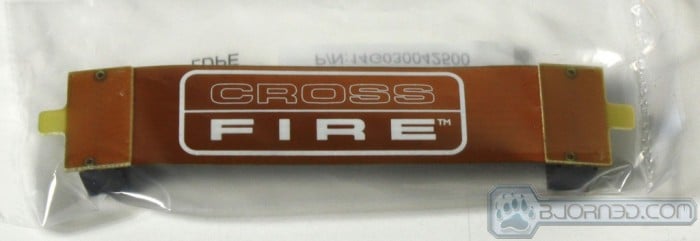
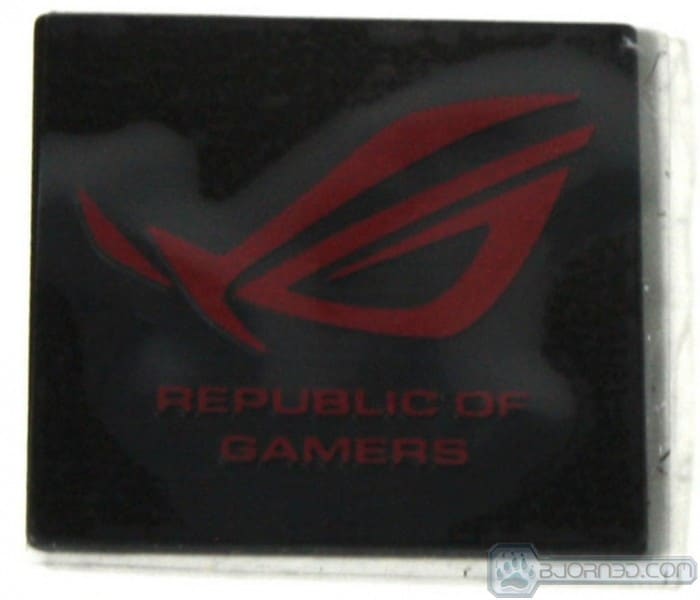


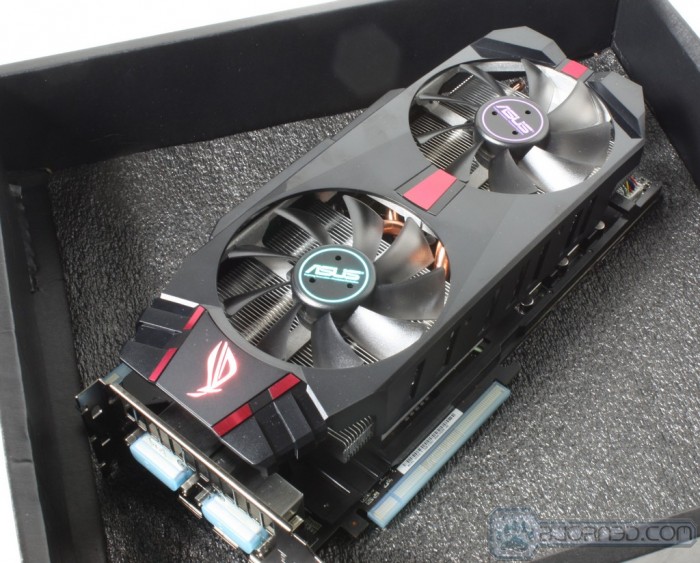
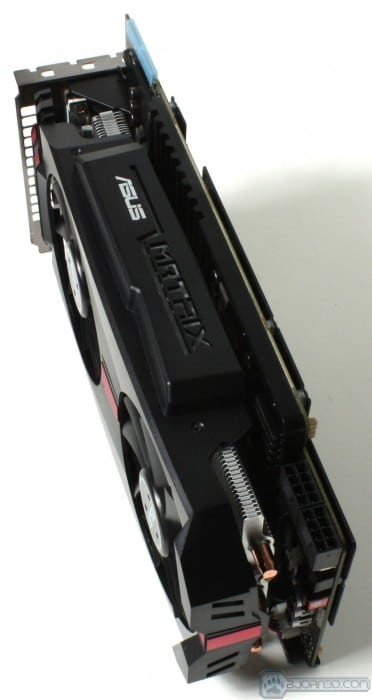

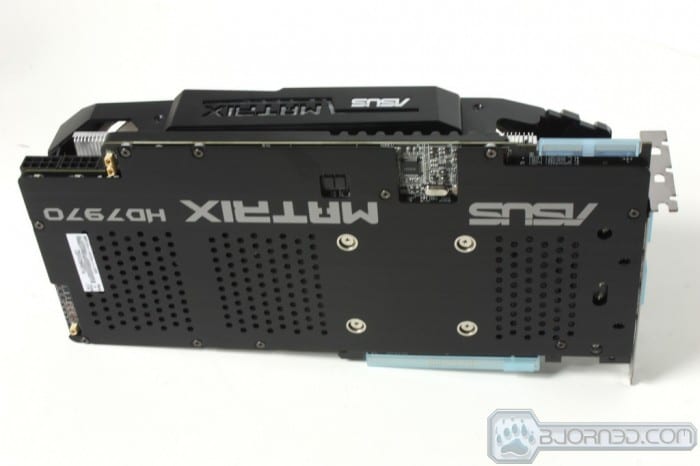











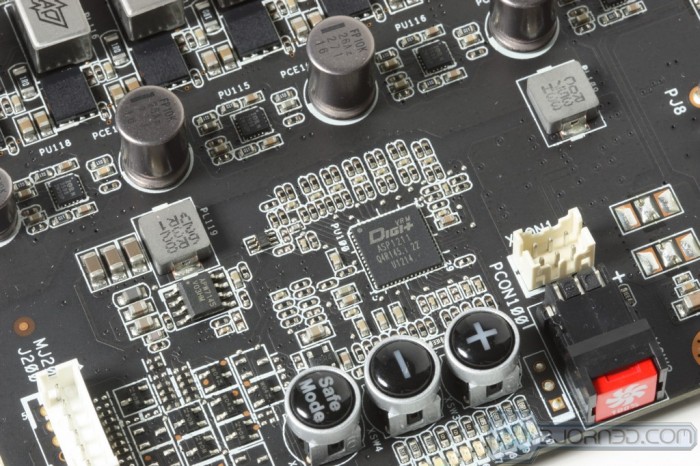
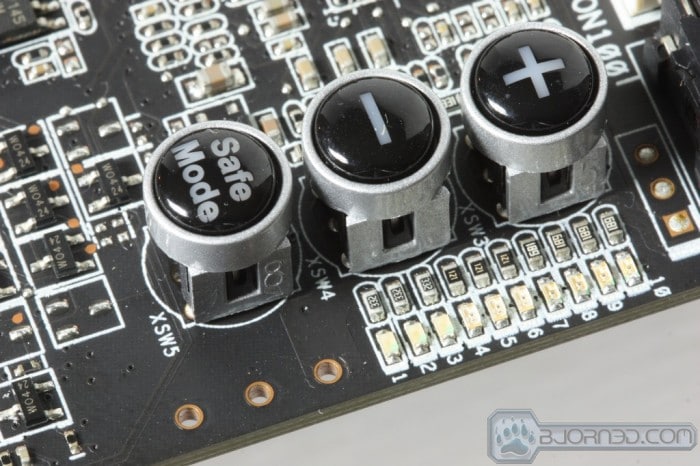
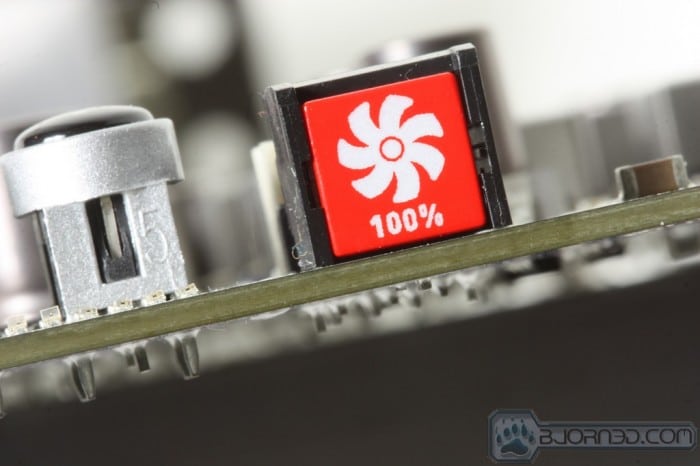




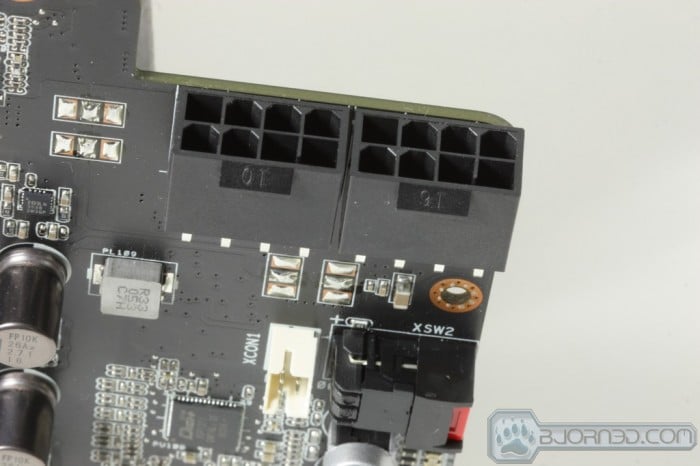










I don’t know this card can garner a perfect score. A fine piece of engineering it may be but it’s certainly not value for money & is a niche product. A score of 9 would probably be more fitting.
Hi there Wayne,
Normally I could understand where your coming from, if this were lets say a normal card with a non ref cooler or possible small changes. But this is an enthusiasts class card designed to compete with the likes of the MSI Lightning HD7970 (It costs 10 dollars less than the lightning) and therefore value has to be properly placed in respect to the market. I try to look at it similar to a collectors edition game bundle where at the end of the day its the same exact game in the box but in many cases fetches over 100% higher price just for the additional accessories or whatnot included in the box. well this card is only between 10-20% higher cost than the lowest priced standard models but has a much larger feature set than just another HD 7970.
Another example would be the automotive market, Yes a RS Camaro and a SS Camaro both have 4 wheels and the name “Camaro” on them but there are many differences that merit the price jump you pay for an SS version. Just think of the MATRIX HD 7970 as the “HD 7970 SS”
This is the kind of things we have to look at when we make an assesment of the relative value of a card to the market.
Awesome Review!!
Thank you for an un-biased review.
you’re welcome, and we do try. We try to review products for what they are so that you get a better idea of what the product is and where it fits…
Thank you for the reply.
And if you act now, we will throw-in an active “I am not using the card”, neon sign, so you know when you are not using it. Instead of actually just making the card do something that is actually beneficial to being used, while it is being used. Like, I don’t know… an actual exhaust that doesn’t require the use of 20 more fans to be added, thus, sucking all the power the card would have had available to use, if you actually used it. Instead of killing all the rest of the components inside the computer… The RAM, the PSU, the HD/SSD the CPU, the many added fans to actually TRY to exhaust the easy-bake-oven.
Oh, but it has lights! You like lights… Oh, my precious…. Gimme, gimme… All for only an additional $150 more then the original, for the $2.85 in additional hardware.
No Power Consumption for this Card?